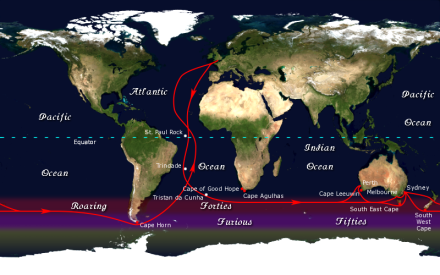History
The VOC ship Zuytdorp left Zeeland in the Netherlands in the summer of 1711 under the command of captain Marinus Wijsvliet on what would be her final voyage. She carried a special cargo of 250,000 newly minted guilders for VOC use in Asia. Before Zuytdorp reached the Cape of Good Hope, 112 members of her original crew had died due to bad conditions on board the ship when she sailed off the coast of Africa. As a result, new men were enlisted at the Cape.
Together with Kockenge, the Zuytdorp left the Cape of Good Hope bound for Batavia in April of 1712, but the two were separated along the way due to bad weather. Zuytdorp wrecked and sank on the Zuytdorp Cliffs on the west coast of Australia, north of Kalbarri. Her location is only known because of the eventual discovery of the wreck, as the fate of the survivors remains a mystery.
As there were no surviving crew members to give clues as to Zuytdorp's fate, no search or salvage operation was undertaken by VOC officials when it became clear that she must have been lost. A tantalizing hint of the survivors’ fates lies in the stories told by local Aboriginals of white people camping on their land around the time of the wreck. There are also stories of fair-haired Aboriginals, leading many to the conclusion that the surviving crew members of Zuytdorp may have stayed close to the site of the wreck in hopes that another ship would pass and rescue them, and eventually integrated with the local Aboriginals.

Roaring Forties
The Roaring Forties is the name given to strong westerly winds found in the Southern Hemisphere generally between the latitudes of 40 and 50 degrees. Air displaced from the Equator towards the South Pole, which travels close to the surface between the latitudes of 30 and 60 degrees south, combines with the earth's rotation to cause west-to-east air currents. The Roaring Forties was a major aid to trade ships sailing from Europe to the East Indies or Australasia during the Age of Sail.
The location of the Roaring Forties is not consistent, and shifts north or south depending on the season. Similar but stronger conditions occur in more southerly latitudes and are referred to as the Furious Fifties and Shrieking or Screaming Sixties. During the Age of Sail, ships travelling from Europe to the East Indies or Australasia would sail down the west coast of Africa and around the Cape of Good Hope to use the Roaring Forties to speed their passage across the Indian Ocean, then on the return leg, continue Eastwards across the Pacific Ocean and under Cape Horn before sailing up the east coast of the Americas to home. "To run the easting down" was the phrase used to describe the fast passages achieved in the Roaring Forties.

Description
The VOC ship Zuytdorp was a Dutch East Indiaman (spiegelretourschip). It was built in 1701 at the Vlissingen shipwright in Zeeland for the VOC Chamber Middelburg Zeeland.

Gerrit Groenewegen, VOC ship, 18th century.
| Length | 160 Amsterdam feet (45.3 m) |
|---|---|
| Tonnage | 1152 ton (576 last) |
Status
On the cliffs near the site of the wreck, a small camp was discovered by local Tom Pepper as early as 1927. He found bottles, coins dating from 1711, and other artefacts that belonged to survivors of a shipwreck. In 1954 Phillip Playford concluded that the camp must have been that of survivors of the wreck of Zuytdorp due to the date of the coins. In 1964, the actual wreck site of Zuytdorp was discovered.

This archaeological site on the Australian coast is one of the most dangerous and difficult wrecks to explore. The Western Australian Museum (WAMM) became legislatively responsible for the wreck site in 1963, but before that, the site was often visited by amateur archaeologists and sports divers. Between 1971 and 2000, the WAMM carried out extensive archaeological research, not only on the wreck site itself but on the associated campsite and the possible integration of the survivors with the local aboriginals. The research of the wreck site was a very slow process, as the amount of safe diving days on the site during the year is very low.
The ANCODS collection of artefacts contains over 1300 artefacts associated with Zuytdorp. A study is currently underway to assess the number of coins still on the site and the potential for their recovery.
The site has proven to be one of the most difficult and dangerous wrecks to explore on the Australian coast. Following a series of land excavations by amateurs and dives by recreation and land salvage-oriented divers, the Western Australian Museum became legislatively responsible for the site in 1963.
The WA Museum then began a series of salvage attempts aimed at removing the remaining silver bullion in order to deter looters.
In 1992 the wreck’s surroundings were declared the Zuytdorp nature reserve. Access is only granted on permission from the WAMM and diving is prohibited since diving on the wreck site is treacherous.
The wreck site and artefacts and the coast adjacent to the wreck are protected under Commonwealth and Western Australian law. The site is federally protected. Ownership of the collection is in hands of the Western Australian Maritime Museum.

References
- WAMM website.
- WAMM website.
- Dutch-Asiatic Shipping.
Details of voyage 2147.3 from Wielingen. - Playford, P.
Carpet of Silver, The Wreck of the Zuytdorp.
University of Western Australia Press. - 1.04.02 4935 Lijsten van voor de VOC uitgevaren schepen.